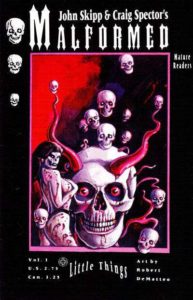 By JOHN SKIPP, CRAIG SPECTOR, ROBERT DEMATTEO (Black Eyed Books; 1992)
By JOHN SKIPP, CRAIG SPECTOR, ROBERT DEMATTEO (Black Eyed Books; 1992)
An intriguing flashback to the indie comic scene of the 1990s, courtesy of the decade’s premiere splatterpunk duo John Skipp and Craig Spector (of splat-happy novels like THE LIGHT AT THE END, THE SCREAM and THE BRIDGE). MALFORMED, Skipp & Spector’s only foray into comic book scripting, is a 34-page compilation of three stories, illustrated by Robert DeMatteo.
The first story is the Skipp scripted “A Quickie,” involving a man, a woman and a gaggle of gruesome—and apparently supernatural—sea spiders. It’s followed by “The Word Made Flesh,” penned by Spector; about a lizard-like creature birthed from a nasty tumor in a man’s stomach, this tale is notable for an outrageous final page gag. Rounding things out is “Company,” scripted by Skipp and Spector, which features a thoroughly demented family into whose house a most unfortunate young woman enters. As with the previous tale, this one is graced with a twist ending I promise you won’t see coming.
The object here appears to have been to update the EC Comics formula to the splatterpunk era, with old-timey monsters and madness spiced with very nineties-centric nudity and gore (the “Mature Readers” notice on the cover isn’t there for decoration). None of its contents are especially groundbreaking or profound, but MALFORMED is fun, and boasts a unique dialogue bubble-free layout that gives precedence to the authors’ ultra-descriptive prose (“The long umbilical probiscus was last to emerge trailing wetly down the corpse’s cheek as the creature flopped into its lap”). It’s strong enough to make one regret that no further issues of MALFORMED appeared (with the “Vol. 1” on the cover intimating that more were planned).
Regarding the black and white illustrations by Robert DeMatteo, they’re not bad, but, as with many indie comics, aren’t up to professional comic book standards. This is to say that while the various monsters on display are quite striking (the lizard critter of “The Word Made Flesh” in particular), the human figures leave much to be desired, being curiously sketchy and disproportioned. I like to think those problems would have been ironed out in subsequent installments of MALFORMED, but—again—there weren’t any.
